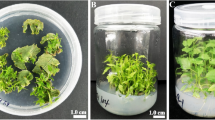Abstract
Tetraploids were successfully produced from diploid seeds obtained through interspecific crossing between Calanthe discolor and Calanthe sieboldii by treating with colchicine or oryzalin. Colchicine was tested at concentrations of 0.05 and 0.1 % for 0, 3, or 7 days and oryzalin was tested at a concentration of 0.003 % for 1, 2, 4, and 7 days, and the ploidy of the seedlings was determined by flow cytometry. Tetraploids (4×) were obtained from the interspecific hybrid seeds treated with all colchicine and oryzalin concentrations. The most efficient condition for inducing tetraploids seemed to be treated with 0.003 % oryzalin for 1 or 2 days. Cytological and morphological evidence confirmed the results of flow cytometric analysis. The stomatal density and sizes of the tetraploid plants were significantly higher and larger than those of the diploid plants. Differences in leaf shape were found between the tetraploid and diploid plants under the same growing conditions: the leaves of the diploids were elongated and those of the tetraploids were round.




Similar content being viewed by others
References
Allum J, Bringloe D, Roberts A (2007) Chromosome doubling in a Rosa rugosa Thunb. hybrid by exposure of in vitro nodes to oryzalin: the effects of node length, oryzalin concentration and exposure time. Plant Cell Rep 26:1977–1984
Chaisan T, Somta M, Srinives P, Chanprame S, Rangsarid K, Dumrongkittikule (2013) Development of tetraploid plants from an interspecific hybrid between mungbean (Vigna radiata) and rice bean (Vigna umbellata). J Crop Sci Biotech 16:45–51
Chen WH, Tang CY, Kao YL (2009) Ploidy doubling by in vitro culture of excised protocorms or protocorm-like bodies in Phalaenopsis species. Plant Cell Tissue Organ Cult 98:229–238
Gale S, Drinkell C (2007) Calanthe arisanensis Orchidaceae. The Board of Trustees of the Royal Botanic Gardens. Kew Plate 596:206–210
Griesbach RJ (1981) Colchicine-induced polypoloidy in Phalaenopsis orchids. Plant Cell Tissue Organ Cult 1:103–107
Jovtchev G, Schubert V, Meister A, Barow M, Schubert I (2006) Nuclear DNA content and nuclear and cell volume are positively correlated in angiosperms. Cytogenet Genome Res 114:77–82
Karnovsky MJ (1965) A formaldehyde-glutaraldehyde fixative of high osmolarity for use in electron microscopy. J Cell Biol 27:137A–138A
Khosravi AR, Kadir MA, Kadzemin SB, Zaman FQ, De Silva AE (2009) RAPD analysis of colchicine induced variation of the Dendrobium Serdang beauty. Afr J Biotechnol 8:1455–1465
Kondorosi E, Roudier F, Gendreau E (2000) Plant cell-size control: growing by ploidy? Curr Opin Plant Biol 3:488–492
Kurzweil H (2007) Taxonomic problems in the genus Calanthe. In: Proc 9th Asia Pacific Orchid Conf, Seoul, Korea, 16–19 March 2007, pp 387–392
Miguel TP, Leonhardt KW (2011) In vitro polyploid induction of orchids using oryzalin. Sci Hortic 130:314–319
Miyashita C, Ishikawa S, Mii M (2009) In vitro induction of the amphiploid in interspecific hybrid of blueberry (Vaccinium corymbosum × Vaccinium ashei) with colchicine treatment. Sci Hortic 122:375–379
Miyoshi K, Mii M (1998) Stimulatory effects of sodium and calcium hypochlorite, pre-chilling and cytokinins on the germination of Cypripedium macranthos seeds in vitro. Physiol Plant 102:481–486
Murashige T, Skoog F (1962) A revised medium for rapid growth and bioassays with tobacco tissue cultures. Physiol Plant 15:473–497
Perry JL, Lyrene PM (1984) In vitro induction of tetraploidy in Vaccinium darrowi × V. elliottii, and V. darrowi × V. elliottii with colchicine treatment. J Am Soc Hortic Sci 109:4–6
Ramulu KS, Verhoeven HA, Dijkhuis P (1991) Mitotic blocking, micronucleation, and chromosome doubling by oryzalin, amiprophos-methyl, and colchicine in potato. Protoplasma 160:65–71
Sarathum S, Hegele M, Tantiviwat S, Nanakorn M (2010) Effect of concentration and duration of colchicine treatment on polyploidy induction in Dendrobium scabrilingue L. Eur J Hortic Sci 75:123–127
Silvia PAKX, Callegari-Jacques S, Bodanese-Zanettini MH (2000) Induction and identification of polyploids in Cattleya intermedia Lindl. (Orchidaceae) by in vitro techniques. Cienc Rural 30:105–111
Stoddard EM (1965) Identifying plants by leaf epidermal characters. Connecticut Agric Exp Stn New Haven 227:3–9
Tahara M, Kato M (1987) Polyploidy and hybridization in Habenaria and Calanthe In: Proc World Orchid Hiroshima Symp, Hiroshima, Japan, 23–25 March 1987, pp 79-82
Tosca A, Pandolfi S, Citterio S, Fasoli A, Sgorbati S (1995) Determination by flow cytometry of the chromosome doubling capacity of colchicine and oryzalin in gynogenetic haploids of Gerbera. Plant Cell Rep 14:455–458
Van Tuyl JM, Meijer H, Van Dien M (1992) The use of oryzalin as an alternative for colchicines in in vitro chromosome doubling of Lillum and Nerine. Acta Hortic 325:625–630
Vanstechelman I, Eeckhaut T, Van Huylenbroeck J, Van Labeke MC (2010) Histogenic analysis of chemically induced mixoploids in Spathiphyllum wallisii. Euphytica 174:61–72
Watrous SB, Wimber DE (1988) Artificial induction of polyploidy in Paphiopedilum. Lindleyana 3:177–183
Wimber DE, Van Cott A (1966) Artificially induced polyploidy in Cymbidiums. In: Proc 5th World Orchid Conf, Long Beach, CA, USA, 11–22 April 1966, pp 27–32
Yamamoto M, Miyoshi K, Ichihashi S, Masahiro M (2012) Ionic compositions play an important role on in vitro propagation of PLBs of spring-flowering Calanthe. Plant Biotechnol 29:71–76
Acknowledgments
This paper was supported in part by the Sunchon National University Research Fund in 2013.
Author information
Authors and Affiliations
Corresponding author
Rights and permissions
About this article
Cite this article
Chung, M.Y., Kim, C.Y., Min, J.S. et al. In vitro induction of tetraploids in an interspecific hybrid of Calanthe (Calanthe discolor × Calanthe sieboldii) through colchicine and oryzalin treatments. Plant Biotechnol Rep 8, 251–257 (2014). https://doi.org/10.1007/s11816-014-0317-4
Received:
Accepted:
Published:
Issue Date:
DOI: https://doi.org/10.1007/s11816-014-0317-4




